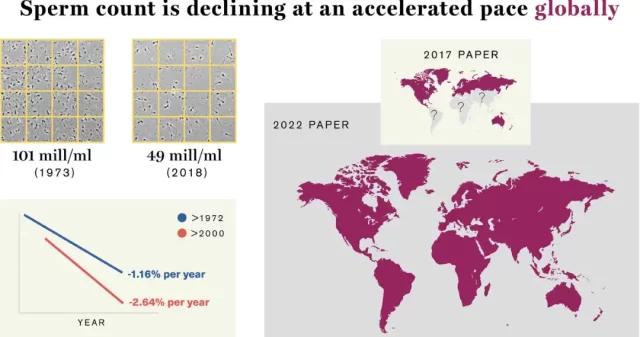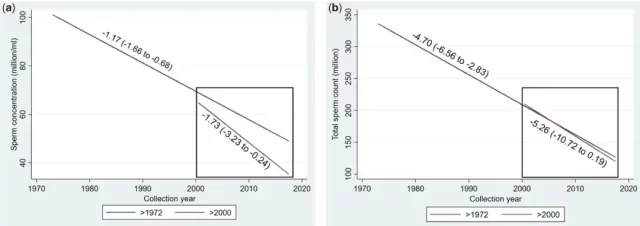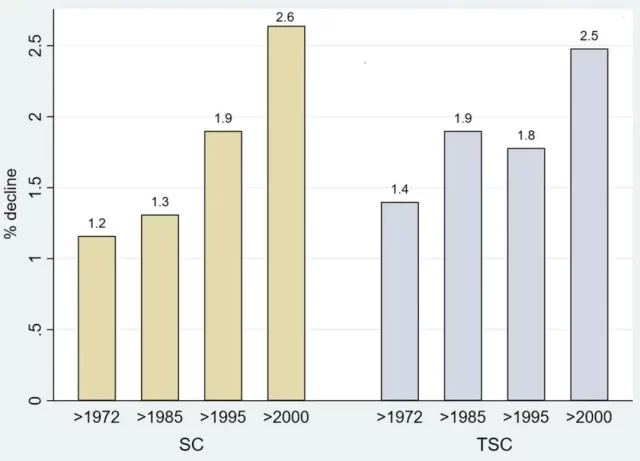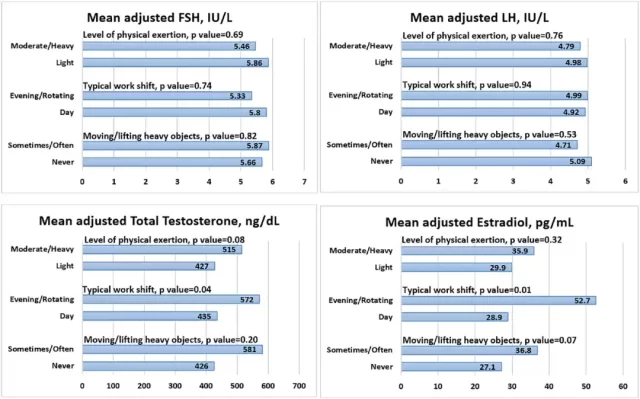Harvard: Men who often do physical work will have stronger reproductive ability
- Normal Liver Cells Found to Promote Cancer Metastasis to the Liver
- Nearly 80% Complete Remission: Breakthrough in ADC Anti-Tumor Treatment
- Vaccination Against Common Diseases May Prevent Dementia!
- New Alzheimer’s Disease (AD) Diagnosis and Staging Criteria
- Breakthrough in Alzheimer’s Disease: New Nasal Spray Halts Cognitive Decline by Targeting Toxic Protein
- Can the Tap Water at the Paris Olympics be Drunk Directly?
Harvard: Men who often do physical work will have stronger reproductive ability, and their sperm concentration and total number will be significantly higher by 46% and 44%!
- Should China be held legally responsible for the US’s $18 trillion COVID losses?
- CT Radiation Exposure Linked to Blood Cancer in Children and Adolescents
- FDA has mandated a top-level black box warning for all marketed CAR-T therapies
- Can people with high blood pressure eat peanuts?
- What is the difference between dopamine and dobutamine?
- How long can the patient live after heart stent surgery?
Harvard: Men who often do physical work will have stronger reproductive ability, and their sperm concentration and total number will be significantly higher by 46% and 44%!
It is estimated that 10-15% of couples of reproductive age worldwide face infertility. Among them, the problem of “male sperm quality” is the most common single influencing factor, and the resulting infertility cases account for about 40% of the total .
Male infertility reflects the decline of male sperm quality from the side, and the research on Human Reproduction Update more intuitively highlights this “worrisome” phenomenon- in the past 50 years, the concentration of male sperm has dropped by 51.6%, and the total sperm count A drop of 62.3%, and the rate of decline continues to accelerate!

Research Overview (https://doi.org/10.1093/humupd/dmac035)
The researchers collected relevant studies from 1973 to 2019, and after rigorous screening, a total of 223 studies from 53 countries were included. Changes in sperm concentration (SC) and total sperm count (TSC) were primarily assessed .
The simple linear model showed a sharp decline in SC between 1973 and 2018 – at a rate of 0.93% per year, for a cumulative decline of 41.5% over the 46-year period of the statistics .
And this downward trend was more obvious in the nulliparous group. Models adjusted for confounding factors showed that the average SC in nulliparous men decreased from 101.2 million/ml in 1973 to 49 million/ml in 2018, an overall decrease of 51.6%.
In less than 50 years, the concentration of male sperm has been astonishingly “cut in half”!
The change in TSC is also similar, and there has also been a sharp drop. From 1973 to 2018, the TSC of nulliparous men dropped from 335.7 million to 126.6 million, an average annual decrease of 1.40%, and an overall decrease of 62.3% .

Model of changes in SC and TSC during the survey period
What is even more “staggering” is that as time goes by , the decline rate of SC and TSC is constantly increasing——
The decline rate of SC in the figure below has increased significantly. The decline rate of SC around 1972 was only 1.16%, but it had climbed to 2.64% around 2000. This rate of descent is comparable to that of a “jumping machine”, directly doubled!
Similarly, the rate of TSC decline around 2000 was “steeper” than that in 1972. Specifically, the average annual rate of TSC decline around the turn of the millennium reached 2.5%.

The decline of SC and TSC in different periods
As the largest analysis of sperm trends in history, it has given mankind a warning—the concentration and total number of sperm have dropped sharply in the past 50 years, or it may become the next “human crisis”. This is why “donating and storing qualified sperm is imminent”.
What factors can affect the quality of male sperm?
In fact, in addition to infertility, decreased sperm concentration and quantity are further closely linked to increased all-cause mortality and multiple disease morbidity.
In addition, a decline in sperm count is often accompanied by a drop in testosterone, a higher incidence of testicular cancer, and abnormalities of the male genitalia.
Therefore, the global decline in male sperm quality has developed into a major public health problem, and “how to improve sperm quality” needs to be resolved urgently.
In addition to the well-known environmental chemicals, dietary factors, BMI, and waist circumference that can affect male reproductive health, a recent Harvard University study on Human Reproduction shows that differences in physical labor caused by occupations are also important factors affecting male fertility one.
Specifically, men who frequently lifted or moved heavy objects at work had a significantly higher sperm concentration of 46% and a total sperm count of 44% higher compared to those engaged in light physical labor!

https://doi.org/10.1093/humrep/dead027
Of the 377 people who were eventually included in the study, 12% needed to frequently lift or move heavy objects at work, and another 6% reported intense physical exertion at work. In addition, 9% of men work night shifts, night shifts and shifts at work.
Models after adjusting for confounding factors showed that men who frequently lifted or moved heavy objects in their jobs had 46% and 44% higher sperm concentrations and total counts, respectively, compared with those who never did heavy-lifting jobs .
Likewise, among men engaged in heavy physical activity, the mean sperm concentration was 68.1 million/ml and the total sperm count was 161.0 million; these two values were significantly higher than those who engaged in light physical activity (34.3 million/ml and 87.4 million).


Relationship between occupational factors and sperm concentration and total number
In addition, the researchers also found that men who did more physical labor at work had higher levels of sex hormones.
Specifically, compared with those who engaged in light physical work, men who required moderate/heavy physical work had higher total testosterone levels, with an adjusted mean of 515 ng/dl, compared with 427 ng/dl for the former; Similarly, total testosterone levels in men who frequently had to move or carry heavy objects at work were significantly higher by 155 ng/dl than those who never did.
In fact, the hormone testosterone regulates a variety of important physiological processes, including: muscle protein metabolism, sexual and secondary sex characteristics, cognitive function, red blood cell production, and more. Within healthy levels, higher levels of total testosterone in the plasma naturally confer certain health benefits.
Interestingly, in addition to total testosterone, there was also a difference in one sex hormone — estradiol concentrations. Men who regularly lift heavy loads at work or perform heavy physical labor have higher levels of estradiol in their bodies.
Why is there an increase in estrogen? The researchers believe that men who engage in heavy physical labor tend to have more testosterone in their circulation. In order to maintain the hormone at a normal level, the excess testosterone will be converted into estrogen under the action of aromatase, which manifests as two reproductive functions. A synergistic rise in hormones.

Relationship Between Occupational Factors and Sex Hormones
In summary, there is a strong link between physical activity and fertility—men who do more physical work in their occupations have higher sperm concentrations and total counts.
On the other hand, you know everything you know.
Reproductive health is important, not only for improving fertility, but also for a variety of common chronic diseases, the researchers said.
Therefore, for men who are usually engaged in light physical work, they can consider lifting iron “voluntarily” during off work, and “forcibly” increasing daily heavy physical labor is also responsible for their own health.
References:
[1]Mínguez-Alarcón L, Williams PL, Souter I, Ford JB, Ghayda RA, Hauser R, Chavarro JE; Earth Study Team. Occupational factors and markers of testicular function among men attending a fertility center. Hum Reprod. 2023 Feb 11:dead027. doi: 10.1093/humrep/dead027. Epub ahead of print. PMID: 36772979.
[2]Hagai Levine, Niels Jørgensen, Anderson Martino-Andrade, Jaime Mendiola, Dan Weksler-Derri, Maya Jolles, Rachel Pinotti, Shanna H Swan, Temporal trends in sperm count: a systematic review and meta-regression analysis of samples collected globally in the 20th and 21st centuries, Human Reproduction Update, Volume 29, Issue 2, March-April 2023, Pages 157–176, https://doi.org/10.1093/humupd/dmac035
Harvard: Men who often do physical work will have stronger reproductive ability, and their sperm concentration and total number will be significantly higher by 46% and 44%!
(source:internet, reference only)
Disclaimer of medicaltrend.org
Important Note: The information provided is for informational purposes only and should not be considered as medical advice.



